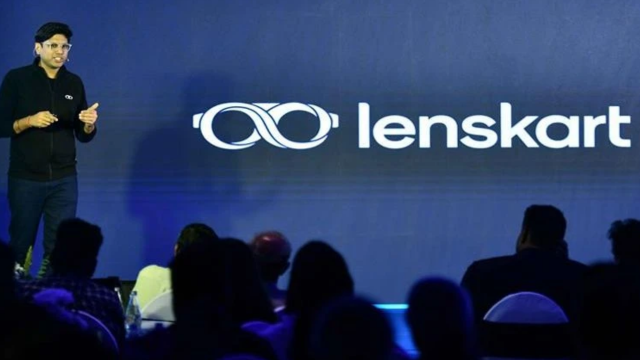November 10, 2025 : Indian eyewear retailer Lenskart Solutions’ shares made a turbulent debut in the stock market on November 10, but they managed a recovery that saw the price move above the IPO issue price. Investors and market watchers are now scrutinising whether the stock offers a good buy or if caution is warranted due to valuation concerns. The company’s listing marked one of the largest public offerings of the year and has attracted both strong interest and debate around its long-term investment case.
The IPO was priced at ₹402 per share and the company raised around ₹7,278 crore through a combination of fresh issue and offer-for-sale. Initial investor enthusiasm was high—Lenskart’s IPO subscription level reached over 28 times overall with strong institutional participation. However, when the stock actually listed, it opened at a noticeable discount. On the BSE, it began at ₹390 per share—about 2.99 per cent below the issue price—and on the NSE the opening was ₹395, a slump of 1.74 per cent. This muted start reflected some investor caution, despite strong brand visibility and growth narrative.
Shortly after listing, Lenskart’s shares dropped further, hitting intra-day lows of around ₹355 on the BSE and ₹356 on the NSE, representing an 11 % decline from the IPO price at one point. The swing exposed how sensitive investors are to the company’s valuation and profitability outlook. Yet, by midday the stock recovered and traded above the IPO price once again—hitting levels around ₹404-₹413.75 per share on the NSE. At one point the share price gained over 6 per cent from the listing price and 2-3 per cent above the IPO price.
This rebound suggests investors may still be betting on the company’s long-term potential in the rapidly growing organised eyewear market, but analysts remain divided on whether this is a time to buy, hold or sell. On the positive side, Lenskart’s strengths are clear: a strong brand, omnichannel business model (retail plus online presence), aggressive expansion across India and internationally, and growing demand for eyewear and vision correction. These factors support the long-term growth story.
However, the concerns are equally strong. Several brokerages have flagged that the valuation is “stretched” given the company’s current profitability and return metrics. For example, one brokerage sets a price target of just ₹337, signalling potential downside of around 16-20 per cent from the issue price. The key risks include heavy capex for store expansion, manufacturing set-up, margin pressure in a competitive and price-sensitive retail sector, slower cash–flow generation and high expectations baked into the listing price.
For investors thinking about what to do now, here’s a breakdown of recommended strategies based on their risk tolerance:
Buy (Long-Term Perspective): For investors who believe in the growth story of eyewear in India and abroad, Lenskart may be a candidate for accumulation. The brand’s strong presence, omnichannel approach and promise of expansion make a compelling case for the long haul. Those willing to ignore short-term price swings and focus on 5-10 year potential may consider investing, especially if they enter at or near current levels with a view to hold.
Hold (Wait for Earnings Clarity): For moderate investors, the case may be to hold and watch. The listing recovery is encouraging, but the immediate upside looks limited given the premium valuation. Waiting for 2-3 quarterly results showing profit improvement, margin expansion, and cash-flow stability could provide better entry or exit clarity.
Sell or Avoid (Short-Term or Conservative View): For short-term traders or risk-sensitive investors, the advice may lean toward booking profits or avoiding the share until valuations become compelling. The large IPO size, hefty expectations, and high valuation make the stock vulnerable to negative surprises if growth or profitability falters. Some analysts suggest this is more of an “exit” opportunity rather than a fresh “buy”.
In conclusion, Lenskart’s share market debut and initial recovery tell a mixed story. On one hand, the company’s long-term business fundamentals and market opportunity remain robust; on the other, its short-term valuation and execution risks are meaningful. Investors are advised to align their decision with their time horizon, risk appetite, and whether they believe the company can deliver its ambitious promises.
Summary
Lenskart’s shares recovered above the IPO price after a muted start, but analysts question its steep valuation. Long-term investors may hold, while short-term ones might sell or wait for clarity before buying.


